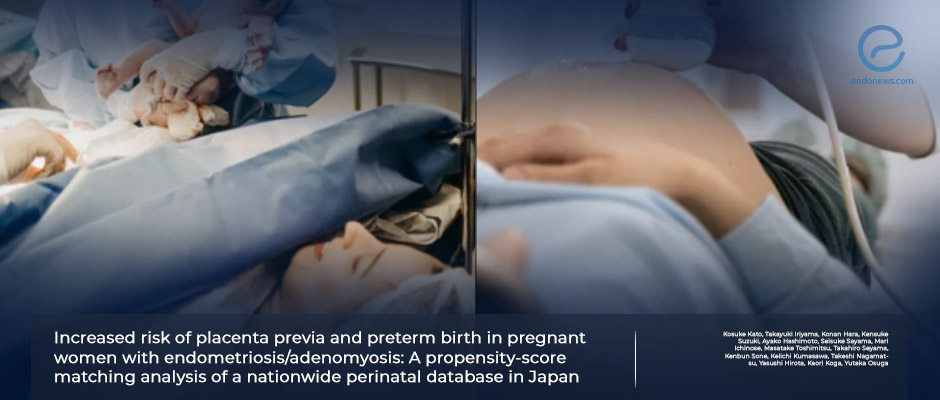Pregnancy outcomes of women with endometriosis/adenomyosis.
Feb 8, 2024
Low-lying placenta and preterm birth are the most common unwanted pregnancy outcomes in Japan.
Key Points
Importance:
- Unwanted pregnancy outcomes such as stillbirth, preterm delivery, and placental disorders are reported in women who were diagnosed with endometriosis and adenomyosis.
Highlights:
- Having endometriosis/adenomyosis mainly cause placental low-lying and preterm birth, but no effect was observed on hypertension-related disorders of pregnancy.
What's done here:
- Using a national database of 203 607 deliveries, and a control group of non-endometriosis/adenomyosis, propensity-score matching adjusted for age, parity, ART, BMI, and smoking history, study assessed the association between endometriosis/adenomyosis and perinatal complications.
- In total, 1203 women from each group were matched and evaluated.
Key Results:
- The rate of placenta previa and preterm delivery were statistically higher in the endometriosis/adenomyosis group.
- Hypertension disorders of pregnancy, were statistically the same when the endometriosis/adenomyosis group and controls were compared.
Strengths and limitations:
- The use of propensity-score matching to analyze a nationwide perinatal database, and the use of a well-documented, physician-driven, high-quality database are the strengths of the study.
Lay Summary
Endometriosis and adenomyosis are diseases presented by ectopic growth of endometrial-gland-like tissues, which we can find in ovaries, pelvic organs, and myometrium. These diseases are causes of hypermenorrhea, dysmenorrhea, chronic pelvic pain, and infertility. Although the number of reports about adenomyosis is less than endometriosis, increased perinatal mortality, small for gestational age, and stillbirths have been reported in those cases. Assisted reproductive technic applications and age are other factors that develop unwanted pregnancy outcomes.
This study aimed to be the largest, most comprehensive, high-quality, and extensive database focusing on the East Asian population on this topic. To achieve this aim, Kato et al. from the Department of Obstetrics and Gynecology of Tokyo University, Japan retrospectively analyzed 145,590 singleton pregnancies from the Japan Perinatal Registry Network database. Women with endometriosis and adenomyosis were designed as the study group, and an equal number of controls were designed using the propensity-score matching method.
Comprehensive and detailed statistical analyses showed an increase in placental disorders such as placenta previa and preterm births in the endometriosis/adenomyosis group. On the other hand, before score matching to build the control group, the determined high tendency for hypertensive pregnancy disorders in the endometriosis/adenomyosis group became equal after matching and comparing the pregnancy outcomes of both groups.
This local but exciting study was recently published in the Journal of Obstetrics and Gynaecological Research.
Research Source: https://pubmed.ncbi.nlm.nih.gov/38072834/
Placental malposition hypertensive disorders of pregnancy placenta previa preterm birth ART pregnancy outcomes adenomyosis endometriosis

